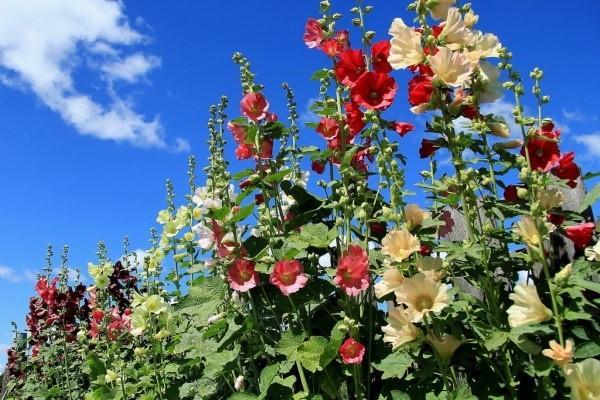Growing mallow in the garden: secrets of lush flowering
 Slender tall peduncles, abundantly strewn with large bright inflorescences, make mallow the queen of the front garden. Growing mallow is not difficult and exciting. Seeing small seedlings, it is difficult to believe that 2-meter bushes will grow from them. But this is the beauty of this amazing flower. For two seasons, he begins to proudly rise above the neighboring plants, ceremoniously shaking the stem in time with the wind. And in order for the mallow to tie a lot of buds, you need to choose the right place for it and occasionally look into the flower bed.
Slender tall peduncles, abundantly strewn with large bright inflorescences, make mallow the queen of the front garden. Growing mallow is not difficult and exciting. Seeing small seedlings, it is difficult to believe that 2-meter bushes will grow from them. But this is the beauty of this amazing flower. For two seasons, he begins to proudly rise above the neighboring plants, ceremoniously shaking the stem in time with the wind. And in order for the mallow to tie a lot of buds, you need to choose the right place for it and occasionally look into the flower bed.
Mallow is a biennial plant, also known as stockrose. In the first year of life, the bushes obtained from seeds grow a dense deciduous rosette. And the peduncle appears only next summer.
Where and how to plant mallow
Terry stuffed inflorescences of the rose stem really resemble wide-open buds garden roses... Both crops require a well-lit area, but mallow also prefers slightly dry soil.
The easiest way to plant mallow in your garden is to sow seeds. This can be done in two ways:
- In April, sow seeds directly into the flowerbed in pre-made grooves or holes. When the seedlings grow up, too thick plantings can be thinned and transplanted. Autumn sowing is also possible, but early emerging seedlings will need to be protected from frost.
- Grow seedlings first, after sowing in late February - early March. In open ground, it can be planted in the month of May.
The seedling method provides one very significant advantage. The biennial will give its first trial flowering this season. True, most often one bush gives one peduncle and with a small number of buds. But you can see what to expect from the plant in the future.
Growing mallow: how to care for a plant
Despite the fact that stockrose is considered a two-year crop, with proper care it will delight with flowering for another 3-4 years. This requires:
- In hot summer, regularly water the bushes (at least 1 time per week) and loosen the soil.
- Weed weeds, especially between young seedlings, so they don't drown them out.
- Install supports and tie up tall stalks, otherwise the wind can break them.
- During the flowering period, feed the flowers with a mineral complex a couple of times. On fertile soil, mallow can even do without additional fertilizing.
- After flowering, cut off the flower stalks.
- Cover the rosettes with leaves in late autumn.
Mallow reproduces wonderfully by self-seeding. When ripe, the seeds fall to the ground or are carried around by the wind. They hibernate in the soil and sprout well in spring. For controlled cultivation of mallow, seeds can be harvested and sown in the desired location. Mallow also reproduces by dividing the bush, but there is one caveat: it is better to divide young rosettes. A too large old bush may not survive this procedure and the delenki will not take root or will hurt for a long time.